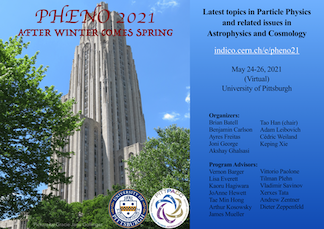Conveners
Higgs I
- Gang Li (UMass-Amherst)
The latest results on the production of Higgs boson pairs (HH) in the ATLAS experiment are reported, with emphasis on searches based on the full LHC Run-2 dataset at 13 TeV. In the case of non-resonant HH searches, results are interpreted both in terms of sensitivity to the Standard Model and as limits on kappa_lambda, i.e. a modifier of the Higgs boson self-coupling strength. Searches for new...
In this talk, we compute the loop corrections to the single Higgs production and decay rates coming from 4 fermion operators of the third generation quarks, which could be tested by current and future ATLAS and CMS measurements of these processes.
These operators have sizeable effects to gluon fusion, $t\bar{t} H$ production cross-sections, as well as Higgs decays to gluons, photons and...
While precision measurements of the Higgs at the LHC continue to confirm its Standard Model-like nature, many of its properties, in particular its couplings to light quarks and to itself, remain essentially unconstrained. Di-Higgs production is well known to be a direct probe of the self coupling, but as I will argue, it is also a powerful probe of Higgs flavor. In models where enhanced...
The recent searches for non-resonant and resonant Higgs pair production with various final states are presented. The analyses are performed using data collected by Compact Muon Solenoid detector with the proton-proton collisions at 13 TeV centre-of-mass energy during the Run2 period. The non-resonant analyses emphasise the results of the cross-section for Higgs pair production and various...
Abstract: We examine the weak boson fusion (WBF) production of exotic heavy Higgs states with subsequent decay into 125 GeV Higgs bosons. We include contributions from the gluon fusion production channel and study the interplay of both production modes to improve the discovery potential at the LHC. We observe that in scenarios with isospin singlet mixing in the Higgs sector, resonant di-Higgs...
A common assumption about the early universe is that it underwent an electroweak phase transition (EWPT). Though the standard model (SM) is able to restore the electroweak symmetry through a smooth cross over PT, we require a strongly first-order PT to ensure electroweak baryogenesis, requiring us to look at new physics beyond the SM. The simplest case to extend the SM is to add a real singlet...
SU(2) triplet Higgs boson with Y=0 hyper charge breaks the custodial symmetry leading to a tree-level vertex with Z and W boson. This prompts the decays into ZW as compared to t b in a doublet charged Higgs case. However, additional Z_2 symmetry can make this triplet as inert leading to displaced mono/di-leptonic signatures. In case of complex triplet, the model produces a pure triplet dark...
